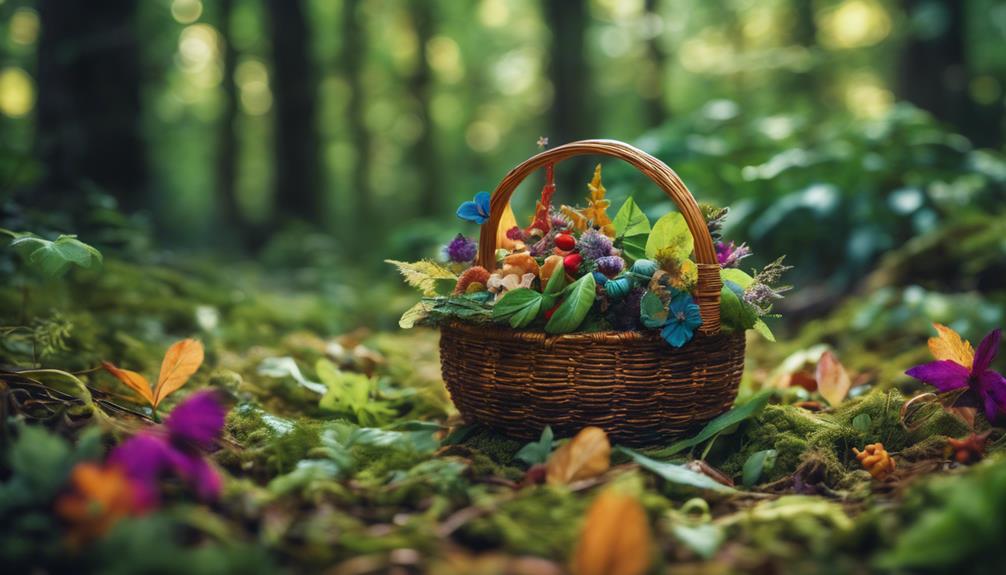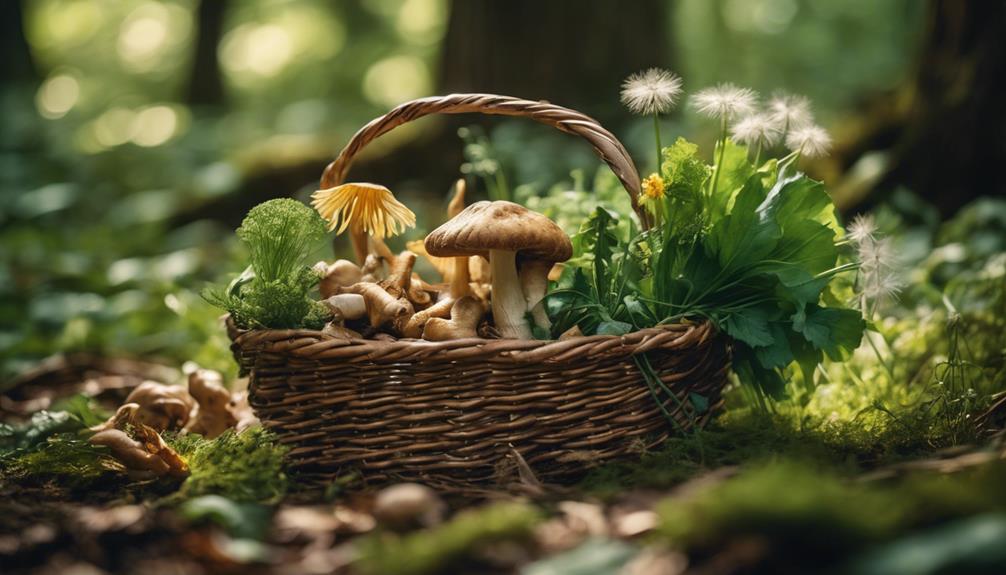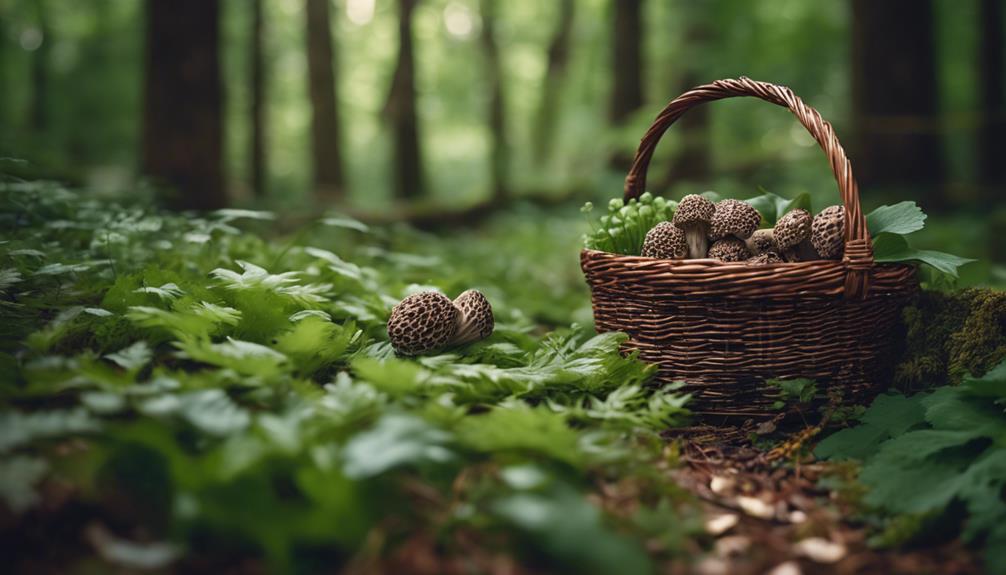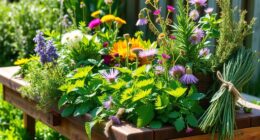To cook wild mushrooms safely, first verify they’ve been correctly identified by a reliable guide or expert. Clean them gently with a damp cloth or soft brush, avoiding soaking. Discard any with slimy surfaces, foul odors, or odd discoloration. Cook thoroughly with methods like sautéing, roasting, or grilling to neutralize toxins. Use high heat and proper seasonings to enhance flavor. For detailed tips on safe handling and cooking, keep exploring the best practices to enjoy your wild mushrooms safely.
Key Takeaways
- Ensure mushrooms are properly identified as edible species by consulting experts or reliable guides before cooking.
- Wash mushrooms quickly with a damp cloth or soft brush, avoiding soaking to prevent sogginess.
- Discard any mushrooms with slimy textures, foul odors, or unusual discoloration indicating spoilage.
- Cook wild mushrooms thoroughly using methods like sautéing, roasting, or grilling to neutralize potential toxins.
- Serve immediately after cooking and store leftovers in airtight containers for up to two days to maintain safety and freshness.
Selecting and Identifying Edible Wild Mushrooms
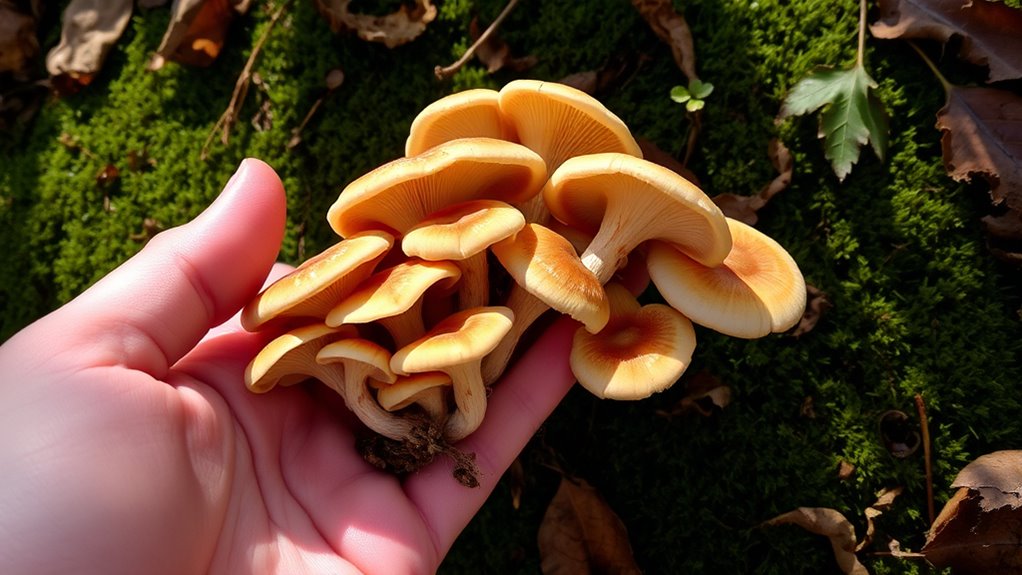
To safely enjoy foraging wild mushrooms, it is essential to accurately identify which ones are edible. Wild mushrooms vary greatly, and many toxic varieties look similar to edible ones. Use reliable field guides or consult experts to distinguish edible mushrooms like ceps, chanterelles, and milkcaps. Look for specific features such as color, gill structure, and cap shape, which help differentiate them from inedible or poisonous types. Avoid collecting mushrooms with white gills, bulbous bases, or strong chemical smells, as these can signal toxicity. Remember, seasonal changes also affect which wild mushrooms are available, and some look-alikes may resemble edible species at certain stages. Always verify your identification through multiple sources or local mycological societies before consumption. Proper data analysis of mushroom features can improve identification accuracy and reduce risks.
Proper Cleaning and Handling Techniques
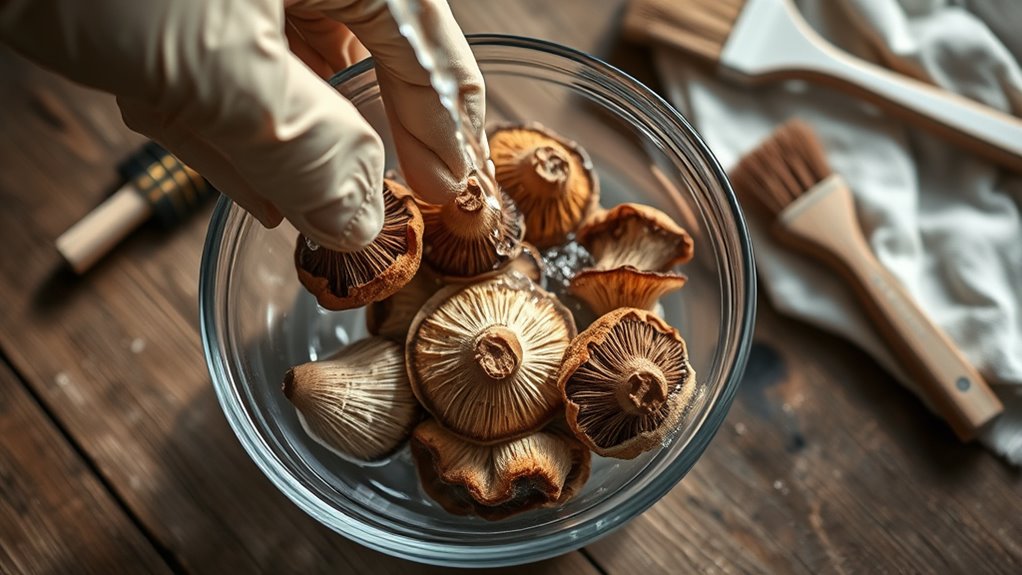
To keep your wild mushrooms fresh and flavorful, use gentle cleaning methods like brushing off dirt or wiping with a damp cloth. If you need to wash them, do so quickly under cold water and dry thoroughly to prevent sogginess. Proper filter replacement is essential to maintain freshness and prevent spoilage, as filters can trap bacteria and mold. Regular tuning of your storage environment, such as controlling humidity levels, can further extend their shelf life and safety. Incorporating data privacy considerations, such as avoiding excess moisture, can further extend their shelf life and safety. Store your mushrooms properly to maintain their quality and prevent spoilage.
Gentle Cleaning Methods
When cleaning wild mushrooms, handle them gently to preserve their delicate texture and flavor. Gentle cleaning methods are key—use a soft brush or a damp cloth to remove dirt and debris without soaking the mushrooms. If washing is necessary, do it quickly under cold running water, then dry thoroughly with paper towels. Wild mushrooms typically have minimal pesticide residues, so focus on removing soil, pine needles, or sand. Avoid soaking them for long periods, as they are porous and will absorb moisture, resulting in a soggy texture. Handling mushrooms delicately during cleaning helps maintain their shape and flavor, especially before cooking. Additionally, being aware of proper handling techniques can prevent damage and ensure the best quality of your mushrooms. Paying attention to mushroom anatomy can further assist in cleaning and handling, ensuring you preserve their natural integrity. Understanding heat pump noise levels ensures your cleaning process remains quiet and undisturbed in your home environment. Incorporating knowledge of harvesting practices can also help you select the freshest mushrooms, thereby reducing the need for extensive cleaning. Being familiar with wild mushroom identification helps avoid dangerous look-alikes and ensures safety during your foraging. By following these gentle cleaning techniques, you ensure your wild mushrooms stay fresh and flavorful for your dishes.
Proper Storage Practices
Proper storage of wild mushrooms begins with handling them carefully to prevent bruising and damage, which can accelerate spoilage. Gently handle your wild mushrooms to maintain freshness and extend their shelf life. Store them in a paper bag in the refrigerator to allow airflow and prevent moisture buildup. Avoid washing mushrooms before storage; instead, clean them just before cooking to preserve texture and safety. Keep wild mushrooms away from direct sunlight and high humidity, as these conditions promote mold and deterioration. Consume your stored wild mushrooms within 1-2 days for ideal flavor and safety. Proper storage practices ensure your wild mushrooms stay fresh, safe, and ready for your next delicious dish.
- Use a paper bag for breathability
- Keep storage in a cool, dry place
- Handle mushrooms gently to avoid bruising
- Clean just before cooking to prevent spoilage
Recognizing Signs of Spoilage and Toxicity
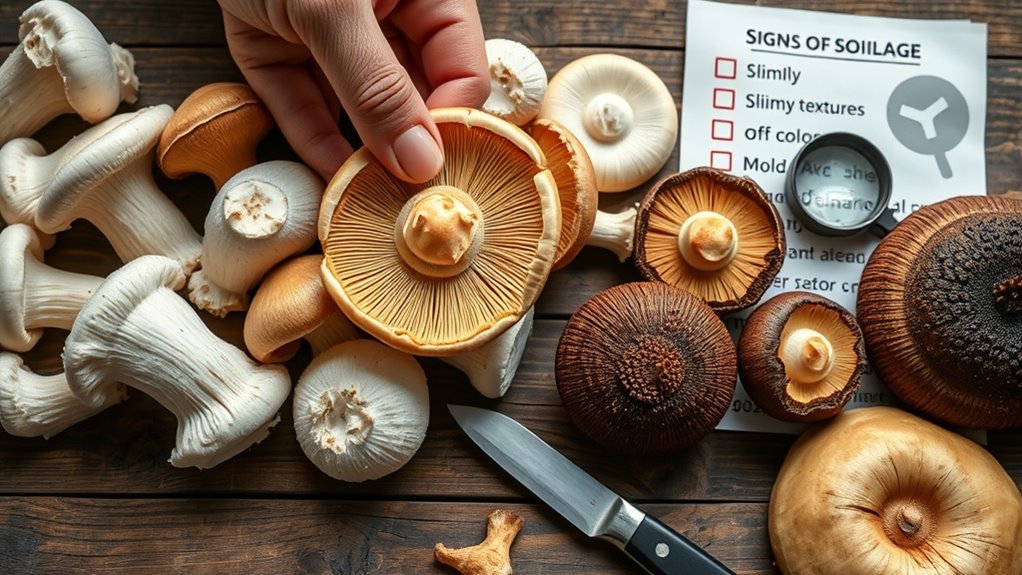
You need to watch for signs that wild mushrooms are no longer safe to eat. Look for unusual color changes, a foul smell, or a slimy, soft texture, as these indicate spoilage or bacterial growth. When in doubt, discard suspicious mushrooms and consult an expert to avoid health risks. Additionally, proper identification techniques can help prevent accidental ingestion of toxic varieties. Regularly inspecting mushrooms for visible signs of decay can further ensure your safety before consumption. Being aware of harvesting best practices can also reduce the risk of collecting poisonous mushrooms and enhance your foraging safety. Furthermore, understanding appliance maintenance plans and their importance can be crucial if you’re using electric tools or appliances during foraging or processing, helping to prevent accidents or equipment failures. Remember that understanding special occasions related to foraging can also inform safer harvesting practices.
Unusual Color Changes
Unusual color changes in wild mushrooms can be strong clues that they are spoiled or toxic. If you notice sudden discoloration, such as darkening, greenish hues, or bright spots like blue or black, it’s a sign that spoilage or bacterial growth may have occurred. Discoloration after cooking, especially a greenish tint, often indicates chemical changes or deterioration, particularly if paired with a foul odor. Persistent or odd coloration that doesn’t match the mushroom’s natural appearance suggests potential toxin development. Always scrutinize abnormal colors carefully. Unique and Wicked Planters can sometimes be used as a metaphor for how unpredictable mushroom appearances can be, emphasizing the importance of careful identification. Recognizing toxicity signs such as unexpected coloration is essential for safe mushroom consumption. Additionally, understanding the resources and tools available for proper identification can greatly reduce the risk of consuming poisonous varieties. Being aware of proper identification techniques can help distinguish safe from dangerous mushrooms before consumption.
Foul Odor Detection
How can you tell if wild mushrooms are spoiled just by their smell? If they emit a foul odor—such as sour, rotten, or ammonia-like smells—you should discard them. Toxic or inedible mushrooms often produce strong chemical or pungent odors, unlike the mild earthiness of fresh varieties. A fishy or rancid smell also signals spoilage and poses health risks. Trust your nose; any unusual or foul smell indicates spoiled mushrooms and the potential presence of toxins. Recognizing odor changes is crucial, as they often reflect chemical alterations that make the mushrooms unsafe to eat. Additionally, texture and appearance can provide clues about freshness, complementing odor detection. Being aware of symptoms of spoilage can help prevent food poisoning and health hazards. It’s also helpful to familiarize yourself with safe handling practices for wild mushrooms to avoid accidental ingestion of toxic varieties.
Slimy or Soft Texture
A slimy or overly soft texture in wild mushrooms is a clear sign that they may be spoiled or contaminated. Excess moisture and a slimy coating often indicate bacterial growth, increasing the risk of foodborne illness. Mushrooms that feel leathery or limp after cooking could be inedible or toxic, especially if they emit a foul odor. Properly fresh wild mushrooms should feel firm; any softness signals spoilage or contamination. Before cooking, check for signs like sliminess or excessive moisture, which suggest they’ve absorbed too much moisture or are past their prime. Discard mushrooms with these signs to avoid health risks.
- The presence of a sticky or slimy surface indicates bacterial activity.
- Excess moisture often results from improper storage or washing.
- Sliminess before cooking suggests possible mold or contamination.
- A soft, leathery texture signals deterioration and potential toxicity.
Preparing Mushrooms for Cooking
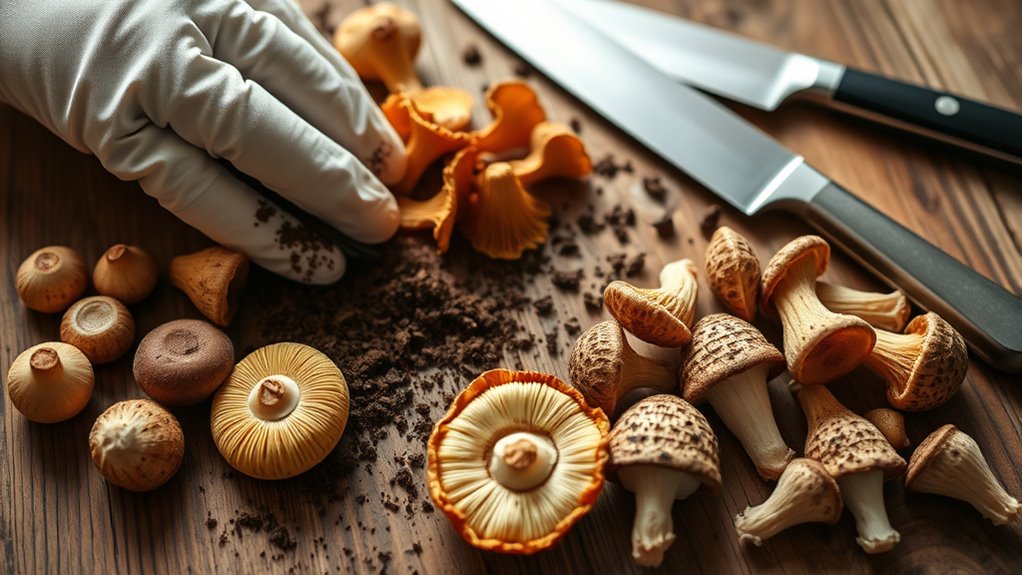
Before cooking wild mushrooms, it’s essential to clean and prepare them properly. Start by gently washing them with a damp paper towel or using a soft brush to remove dirt and debris—avoid soaking, as wild mushrooms are porous and can absorb water, which affects texture. If you need to wash, do so quickly in cold water and dry thoroughly afterward to prevent sogginess. Next, trim the stems and remove any damaged or inedible parts to improve flavor and ensure safety. Carefully inspect each mushroom for signs of spoilage, such as sliminess or odd odors, and discard any that show these signs. Properly washing and trimming your mushrooms sets the stage for safe and delicious cooking.
Recommended Cooking Methods for Wild Mushrooms

Choosing the right cooking method can bring out the best in wild mushrooms while guaranteeing they stay safe and delicious. Sautéing over medium-high heat is excellent for evaporating excess moisture, intensifying flavor and improving texture. Roasting at 425°F in a single layer promotes caramelization and crispness, preventing sogginess. For sturdier varieties, grilling with olive oil and seasonings adds smoky flavor and attractive grill marks. Butter poaching gently simmer mushrooms in butter, preserving delicate flavors and moisture. Proper moisture management is key across all methods—avoid excess washing and ensure adequate heat.
- Sautéing for quick flavor enhancement
- Roasting for caramelized, crispy mushrooms
- Grilling for smoky aroma and texture
- Butter poaching for delicate, moist results
Ensuring Safe Consumption and Avoiding Risks
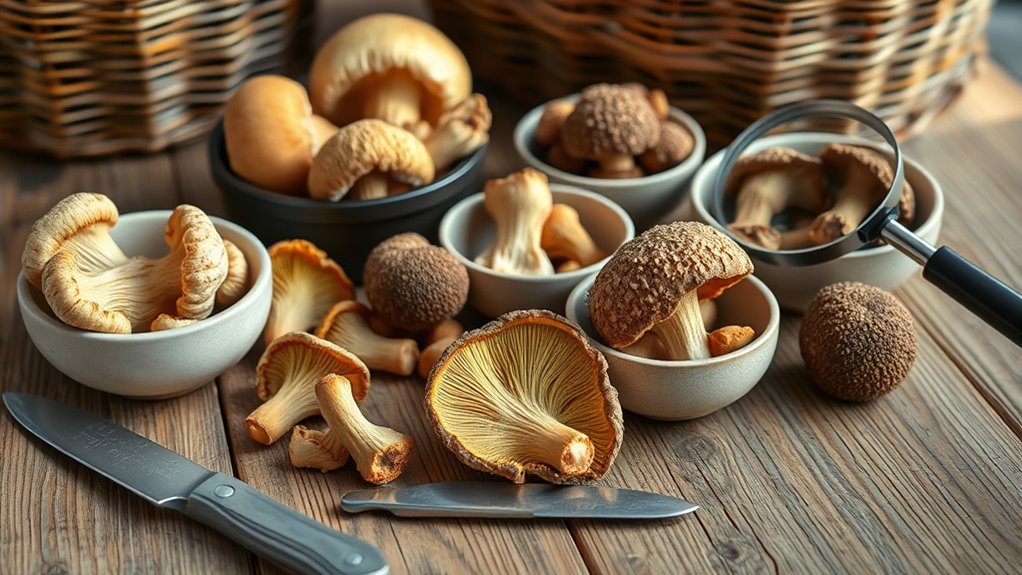
Ensuring safe consumption of wild mushrooms starts with accurate identification, as many edible mushrooms have toxic look-alikes that can cause serious health issues or death. Proper identification is essential; always use trusted field guides or consult with expert foragers, especially in unfamiliar areas. Remember, never eat wild mushrooms raw—cooking neutralizes certain toxins and reduces poisoning risk. Be cautious because inedible or poisonous mushrooms often grow alongside edible ones, making proper identification even more critical. Harvest only mushrooms you’re confident are safe, and avoid taking chances with uncertain specimens. Store your wild mushrooms properly and consume them promptly after cooking to prevent spoilage. By following these steps, you markedly reduce health risks and enjoy wild mushrooms safely.
Tips for Enhancing Flavor While Cooking
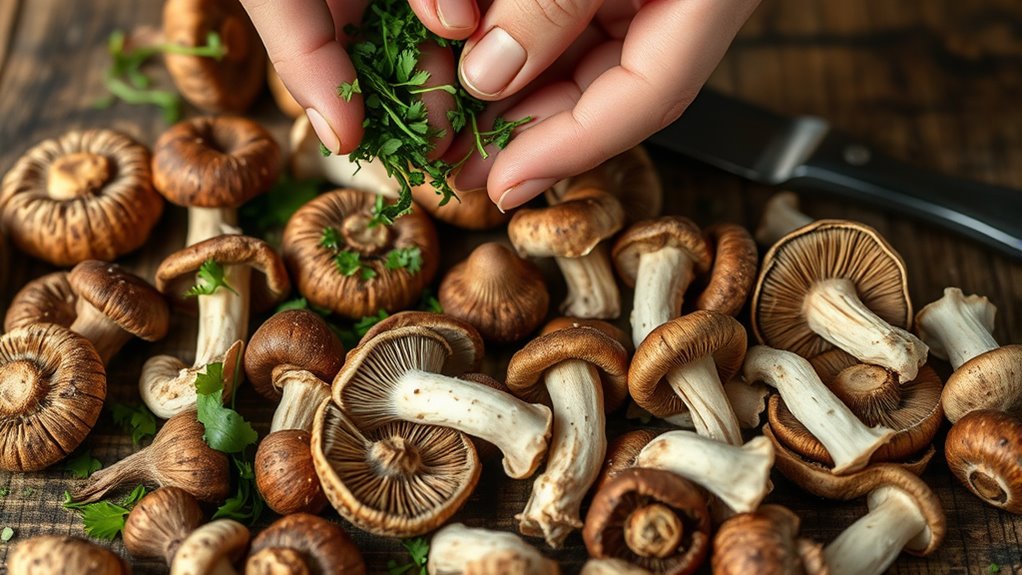
To maximize the flavor of wild mushrooms, focus on proper cooking techniques that develop their natural richness. Sauté them over high heat to promote caramelization, which brings out their deep, savory notes. Incorporate garlic, herbs, or a splash of lemon juice during cooking to enhance their earthy, umami flavors. Use enough fat, like olive oil or butter, to help extract and concentrate their natural juices while preventing moisture loss. Avoid overcrowding the pan, as this inhibits proper caramelization and can cause stewing. Finish with a touch of sea salt or a sprinkle of grated cheese to add complexity. These simple steps will elevate your wild mushroom dishes, making them more aromatic and flavorful.
Sauté wild mushrooms over high heat with garlic and butter for maximum flavor and richness.
- Sauté over high heat for caramelization
- Add garlic for depth and aroma
- Use olive oil to enhance richness
- Finish with salt or cheese for complexity
Serving Suggestions and Storage Tips
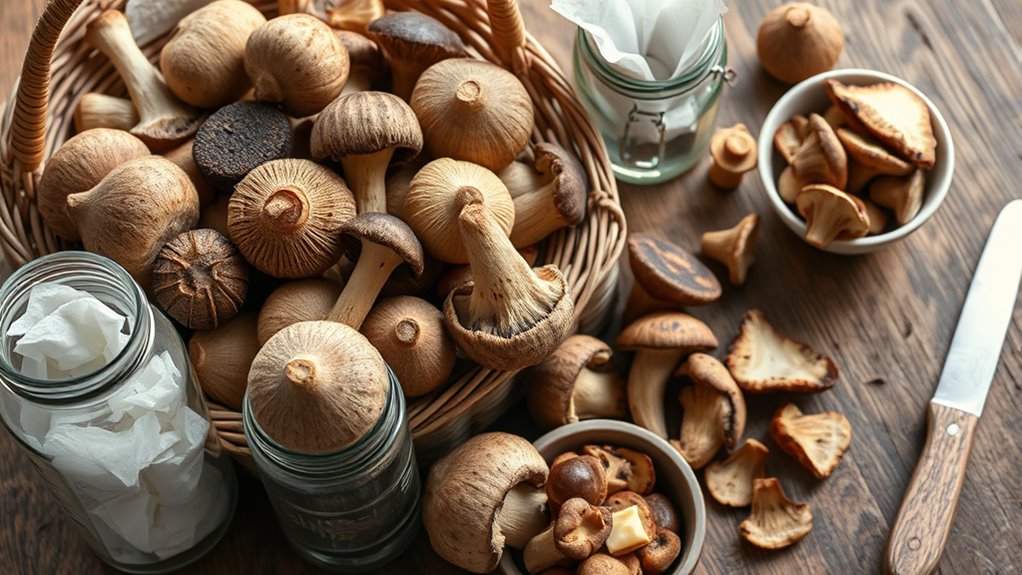
For the best experience, serve wild mushrooms immediately after cooking to preserve their ideal flavor and texture. Serving suggestions include tossing them into salads, pasta, or risottos while still warm. If you need to store leftovers, place cooked wild mushrooms in an airtight container in the fridge for up to two days. Be sure to consume them quickly, as they can become slimy or dry if stored too long. For raw mushrooms, keep them in a paper bag in the fridge to prevent moisture buildup and spoilage. Avoid freezing cooked mushrooms unless they’re part of a sauce or stew, since freezing can change their texture. Always identify wild mushrooms correctly and cook them thoroughly to prevent foodborne illness.
Frequently Asked Questions
How Do You Cook Wild Mushrooms?
You cook wild mushrooms by first cleaning them gently with a soft brush or damp paper towel, avoiding soaking. Tear or cut larger mushrooms into even pieces for uniform cooking. Heat a pan with a bit of butter or oil, then sauté the mushrooms for 1-2 minutes until their juices are released and reabsorbed. Avoid overcooking to prevent mushiness. Finish with lemon or herbs to boost flavor.
How to Clean Wild Mushrooms Before Eating?
Did you know that wild mushrooms can carry dirt and debris that affect their flavor? To clean them, you should avoid soaking; instead, gently brush off dirt with a soft brush or damp paper towel. If they’re very dirty, rinse them quickly under cold water and dry thoroughly. Handle them gently to preserve their texture, and you’ll enjoy their rich flavor and fresh appearance in your dishes.
How to Get Bugs Out of Wild Mushrooms?
To get bugs out of wild mushrooms, start by inspecting each mushroom carefully, especially in crevices and under caps. Use a soft brush or damp cloth to gently clean dirt and insects without soaking them. If bugs are stubborn, briefly freeze the mushrooms for 10-15 minutes to make insects easier to remove. For embedded bugs or heavy dirt, rinse under cold water and dry thoroughly to prevent sogginess.
How to Safely Eat Wild Mushrooms?
Imagine walking through a forest, excited to find a treasure. That’s how you should approach eating wild mushrooms: with caution. Always identify them reliably, avoid eating raw, and cook thoroughly to break down toxins. Start small, and watch for reactions. Just like a treasure requires careful handling, wild mushrooms demand respect and knowledge—mistakes can be serious. When in doubt, consult an expert before tasting.
Are Toxins in Wild Mushrooms Killed in the Cooking Process?
You might wonder if cooking wild mushrooms kills their toxins. While high heat can destroy some surface toxins and reduce bacteria or parasites, it doesn’t eliminate all toxins naturally present. For example, heat-stable toxins like amatoxins in deadly Amanitas remain active even after cooking. Because of this, it’s essential that you correctly identify and source wild mushrooms and don’t rely solely on cooking to make them safe.
Conclusion
By following these simple steps, you’ll turn wild mushrooms into a delightful addition to your meals. With a bit of careful attention, you’ll unseal their natural flavors and enjoy their unique qualities safely. Think of it as a little culinary adventure—each mushroom a tiny treasure waiting to be appreciated. Trust your instincts, handle with care, and savor the experience. Happy foraging and cooking—your taste buds are in for a special treat!




